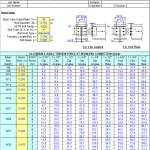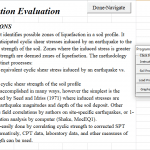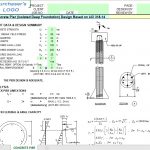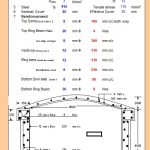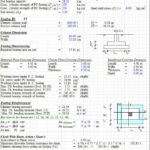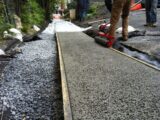
Design Of Expansion Joint For PSC Continuous Type Superstructure Spreadsheet
10 January 2025Table of Contents
Design Of Expansion Joint For PSC Continuous Type Superstructure Spreadsheet
An expansion joint is a structural component designed to safely absorb thermal expansion and contraction, seismic activity, vibration, and other forces that can cause stress in materials. These joints prevent cracking, warping, and structural failure by accommodating movement within a building or infrastructure project.
Why Are Expansion Joints Important in Construction?
- Thermal Movement Accommodation
- Construction materials, such as concrete and steel, expand and contract with temperature changes. Expansion joints allow for this natural movement, preventing damage.
- Seismic Protection
- In earthquake-prone areas, expansion joints act as buffers to reduce stress and prevent structural collapse.
- Vibration Absorption
- For bridges, pipelines, and industrial structures, expansion joints minimize the effects of machinery vibrations and heavy loads.
- Structural Integrity
- They prevent cracking, deformation, and other stress-related damages that can compromise a structure’s durability.
Applications of Expansion Joints in Construction
Expansion joints are used across various sectors of construction, including:
- Buildings
- High-rise buildings, malls, and industrial structures use expansion joints to handle temperature changes and seismic activity.
- Bridges
- Expansion joints accommodate traffic loads, thermal expansion, and vibrations caused by wind or vehicles.
- Roadways
- Asphalt and concrete pavements incorporate expansion joints to avoid cracking during seasonal temperature changes.
- Pipelines
- In oil, gas, and water pipelines, expansion joints reduce stress from thermal expansion and pressure fluctuations.
- HVAC Systems
- Expansion joints in HVAC systems prevent damage to ducts and pipes caused by thermal variations.
Types of Expansion Joints
- Structural Expansion Joints
- Used in buildings to separate sections, allowing independent movement.
- Bridge Expansion Joints
- Designed for large-scale movement caused by thermal expansion, traffic loads, and environmental factors.
- Pipeline Expansion Joints
- Include bellows, slip-type, and rubber joints for handling thermal and mechanical stresses in pipelines.
- Floor Expansion Joints
- Found in flooring systems, allowing tiles or concrete slabs to expand without cracking.
- Roof Expansion Joints
- Installed on rooftops to handle thermal movement and weather-related stress.
Materials Used for Expansion Joints
Expansion joints are made from various materials, chosen based on their intended application and environmental factors. Common materials include:
- Rubber
- Flexible and durable, ideal for absorbing vibrations in bridges and pipelines.
- Metal (Steel, Aluminum)
- Used in high-pressure or high-temperature environments like pipelines and industrial facilities.
- Concrete
- Suitable for pavements and large-scale structures.
- EPDM or Neoprene
- Weather-resistant materials for roofing and outdoor applications.
- Composite Materials
- Combine flexibility and strength for specialized applications.
Installation of Expansion Joints
Proper installation is critical to the performance of expansion joints. Key steps include:
- Planning and Design
- Engineers assess the structure’s thermal, seismic, and mechanical requirements to determine joint placement and type.
- Material Selection
- Choosing materials that can withstand the expected load, temperature, and environmental factors.
- Placement
- Expansion joints are strategically located at stress points, such as between building sections, along bridges, and in long pipelines.
- Sealing
- Joints are sealed with weatherproof and durable materials to prevent water or debris intrusion.
- Inspection
- Post-installation inspections ensure proper alignment and functionality.
Maintenance of Expansion Joints
Regular maintenance is essential to ensure the long-term effectiveness of expansion joints. Best practices include:
- Routine Inspections
- Check for wear, corrosion, or damage caused by environmental factors or heavy use.
- Cleaning
- Remove debris, dirt, and water to prevent deterioration of seals and joint materials.
- Sealant Replacement
- Replace worn-out sealants to maintain waterproofing and flexibility.
- Repair or Replacement
- Damaged joints should be repaired or replaced promptly to avoid structural issues.
- Monitoring
- Use sensors and monitoring systems for critical structures like bridges and pipelines to detect stress and movement.
Benefits of Using Expansion Joints in Construction
- Increased Longevity
- Protects structures from stress-related damage, extending their lifespan.
- Cost Savings
- Reduces the need for costly repairs caused by cracks or deformation.
- Safety
- Minimizes the risk of structural failure, ensuring the safety of occupants and users.
- Compliance with Building Codes
- Expansion joints are often required to meet local construction standards and regulations.
Conclusion
Expansion joints are an indispensable part of modern construction, providing flexibility and protection to structures exposed to thermal, seismic, and mechanical stresses. From high-rise buildings to bridges and pipelines, these components play a critical role in ensuring durability and safety.

